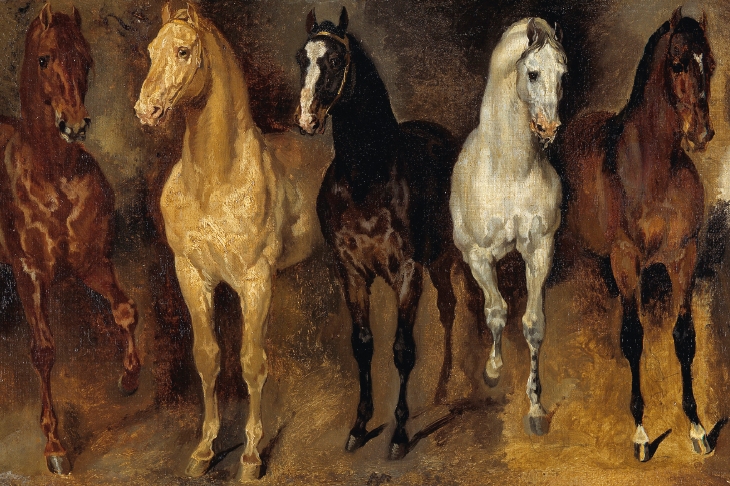Wallace Stevens gave us ‘Thirteen Ways of Looking at a Blackbird’. The German scholar Ulrich Raulff, in this meaty book about the history of man’s partnership with horses, gives us many more than 13 ways of looking at a horse. Horses have had ‘more meanings than bones’, he writes. And those meanings have been central to the human experience since pre-history. Evidence from the abraded teeth of horse skeletons indicates that man first slipped a rope into a horse’s mouth as long ago as 3,700 BCE.
Horses are what Raulff calls ‘converters’: they can unlock the energy in plants and make it available for man’s use. As draught animals they were ‘oat-powered engines’, a single horse delivering roughly seven times the power of a single man. As mounts, they were the first thing that gave us the experience of speed — opening up space to hunting, to new forms of warfare, to colonisation and in the end, to politics. And, as the long iconography of man on horseback shows, they also, literally, raised us up. A king was not a king without his horse. They were, of our many animal companions, first among equals. The man-horse relationship — which Raulff calls ‘the Centaurian Pact’ — only really started to lose its significance in the 20th century — and late, at that.
Raulff divides his survey into what he calls three ‘economies’ in which horses have participated: ‘energy’, ‘knowledge’ and ‘pathos’. That is, their economic or military roles and transformative historical effects; the overlapping and changing fields of first practical, then theoretical or scientific knowledge to do with everything from breeding (the English Stud Book predates Burke’s Peerage by 35 years), to judging horseflesh as a buyer (Xenophon had some warnings about how not to get ripped off by your horse-dealer), biomechanics, engineering, veterinary science and anatomy; and finally their role in the mythopoeic imagination.
Horses have meant everything from kingship to sex (there’s a slightly creepy line, in this very male-dominated book, about ‘the latent sexuality of endless waves of young girls, who throughout the centuries have transformed the riding school into a pleasure ground of pubescent and teenage nymphs’) to wild terror (as in Fuseli’s ‘Nightmare’, but also in the way that the rolling eyes and wild ears of this great flight-animal, in battle, mirrored the feelings of the infantryman facing a cavalry charge) to death itself; the Pale Rider, the revenant horseman. In pursuit of this aspect of horses Raulff offers some bravura discussions of art history and literature, though he doesn’t, disappointingly, find space for Jilly Cooper.
Particularly admirable is the way Raulff attempts to recreate the sensorium of the big city, and the rural village, in the high age of the horse. What did it mean to live in Paris when ‘every 13th Frenchman was a horse’ — the smell of the dung-filled streets; the perpetual danger of boltings and pile-ups (traffic laws being a late-comer, and the invention of the kerb a vital innovation to protect pedestrians); the incessant ring of horseshoes, the neighing and whinnying; or, in rural areas, the absolute centrality of the blacksmith’s forge to village life?
One of the subtlest and most interesting points Raulff makes is that the coming of industrial technologies didn’t immediately supersede the horse: for most of the 19th century they meant we needed even more of them to supply the energy for those innovations. The first combine harvesters were pulled by teams of up to 40 horses. And in war, too, though traditional sabre-swinging cavalries were ever more vulnerable to infantry with repeating rifles, the horse was still vital in the great wars of the 20th century as a draught animal. Even where you had motorised vehicles, a horse could make its way through the mud of the battlefield more reliably than any of them — and when they foundered it was with teams of horses that they were pulled out. Horses dragged artillery, and the bigger the artillery the more horses were needed. The German army used 1.8 million horses in the first world war, and 2.7 million in the second — one for every four soldiers. And the casualty figures for the horses were much higher. About two thirds of them perished.
There are lots of nuggets of fascinating knowledge. Did you know that the first cowboys in America were Jewish (contra the anti-Semitic trope, popular among Cossacks, that Jews were less than human because they didn’t ride)? Or that the use of horses by what Raulff controversially calls ‘Red Indians’ (in fairness he’s busy at the time talking about the fictionalising of the Old West, and they were Injuns in the old ‘horse operas’, no question) was a very late development? Native Americans went on foot, hunted on foot and fought battles on foot, for most of their history. And we meet Comanche, the only non-Indian survivor of the Battle of Little Bighorn, a war hero in retirement and — somewhat unusually for a horse — an amiable alcoholic.
But reader, be warned. Here is an eccentric, deeply learned, frequently brilliant and frequently infuriating book — packed with good things but with all the discipline and composure of an unbroken mustang that has just glimpsed a rattlesnake. Raulff discusses, at some length, around page 54, how Madame Bovary’s husband is mocked for his inelegant horsemanship; and then on page 274 returns to the subject as if it has just occurred to him. The outset of one chapter, set in the Gobi desert in 1879, digresses instantly into a two-sentence discussion of a German science fiction series from a century later that happens, also, to be set in the Gobi desert; there seems to be no more connection than that.
One moment we’re in the 19th century, the next we’re in the late Neolithic. One moment we’re talking John Wayne and Teddy Roosevelt; the next we’re with Cossacks. Another chapter moves from talking about ancient breeds (Przewalski’s Horse, from the aforementioned Gobi desert), to historical etymology (Germans have, we learn, 63 different words for a horse); then we’re onto the story of Clever Hans, the horse claimed in the early 1900s to be able to do arithmetic; the next we’re getting a potted discussion of the invention and importance of the stirrup. It’s demented.
More than the lack of organisation, it is the style that frustrates. Raulff lurches from the concrete and empirical — the 270,000 litres of horse piss produced each day in the New York of 1900, say — to passages of clumsy lyricism, to the conjectural and to the theoretical. Here he’ll be discussing archaeological evidence; there he’ll jump the fence into the paddock containing Deleuze and Guattari, Heidegger and Lacan. 270,000 litres, indeed.
It abounds with writing that is obscure or plain bad. ‘The centaur dominates the 19th century like a landmark,’ he opens one chapter; to which the reasonable reader will respond: nope. Or elsewhere, early on: ‘But the question of evaluation is perhaps one I manage to skirt around without truly answering it; more than something to have and hold, such a question is more of a desideratum: something to hope for or aim at.’ Backward ran sentences, as the man said, until reeled the mind. Put it this way: it’s a book that even in translation still reads like it’s in German.
In 1913, a visitor to his retirement stables found Clever Hans in a diminished state.
He, who had led ‘a puritanical, monastic existence, devoted to celibacy, scholarship and arithmetic’, had allegedly been so inflamed at the sight of a beautiful mare that he had bounded over hedges and fences, ripping the underside of his body so badly that the vet had had to come and stuff his entrails back inside and sew him up.
Can’t blame him, really. One wonders which way Clever Ulrich will go.







Comments